This post is also available in:  Deutsch (German)
Deutsch (German)
If you are visiting Windhoek for the first time, you will soon discover that it is hardly different from any other European city. There are large shopping malls with supermarkets and clothing stores and the restaurants are also rather European, apart from the fact that there is often “Game” on the menu. On the one hand, this is reassuring, because you won’t be overwhelmed by completely strange impressions, but rather you can put the Nutella and Haribo into your shopping cart. On the other hand, you might ask yourself: “Where is the real Africa here? Where can I get to know traditional African life?
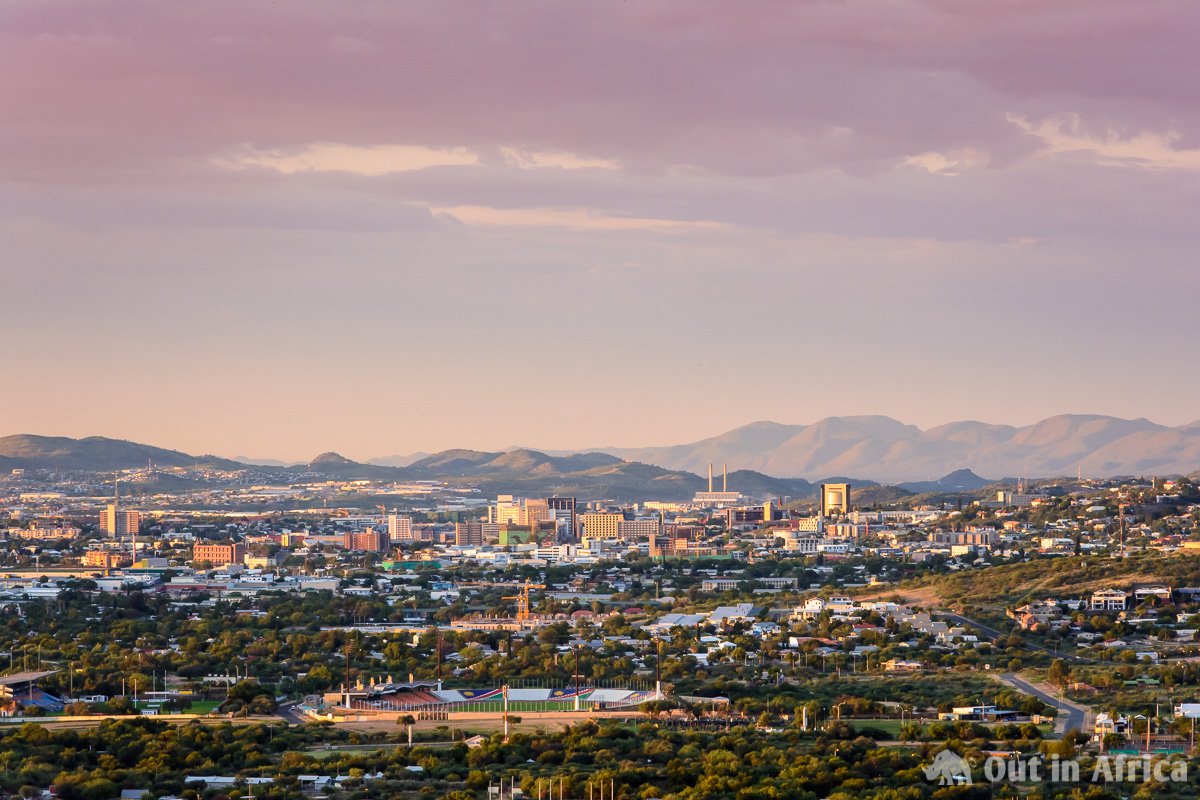
The “true Africa” is very diverse. The skyscrapers, shopping centres, supermarkets and restaurants are part of it. But there is another side – the traditional side, places where there is food that the Europeans don’t know, where clothes don’t come from the Far East, but are made in a tailor’s shop, albeit with modern sewing machines. You don’t have to drive far from downtown Windhoek to experience it. Just drive to Katurura to an Open Market. And while you’re there, visit a traditional African restaurant.
Katutura, the place where we do not want to live
The history of Katutura
“Katutura” – the word comes from the Herero language and means “the place where we don’t want to live.” In the fifties of the last century, the South African regime wanted to separate the population of Windhoek according to race. Until then, the black population lived in the ” Old Location ” or in the city itself. Now they were supposed to move away from there and therefore a new neighbourhood for the black population was constructed from scratch and the people were forcibly resettled.
The black population resisted. There were several reasons for this. Firstly, the resettlement took place under duress, i.e. the people who lived in the old location were deprived of their freedom to live where they wanted. The forced resettlement to Katutura cemented the racial segregation even more. Then the inhabitants were no longer allowed to own the land they lived on, but had to rent it from the city. In addition, the plots were small and hardly permitted the cultivation of vegetables. Finally, the the city was no longer within walking distance, but could only be made by bus, as Katutura was built about 8 km from the city centre. On 10 December 1959 there was an uprising against the forced resettlement on the Old Location, which was brutally crushed. Sam Nujoma, the first president of the independent Namibia took part in it and the uprising itself led to the foundation of SWAPO.
Katutura today
Racial segregation is history. Today black Namibians live in all neighbourhoods of Windhoek. But the end of racial segregation did not mean that white people moved to Katutura. It is one of the poorest neighbourhoods of the city and is almost exclusively inhabited by black people. There are also plots and houses in Katutura, which rather belong to the middle class but mostly the houses and properties are still quite small and sometimes the dwellings are build only of corrugated iron sheets. Over the decades Katutura grew and was extended by quarters like Wanaheda, Okuryangava, Hakahana, Goreangab and Otjimuise.
In Katutura you can experience the “true Africa”, i.e. of course there are shopping centres, supermarkets and restaurants, but there are also several open markets and African restaurants.
Mopane worms
During our last visit to Namibia Anita wanted to visit an Open Market because there and only there you can buy mopane worms.
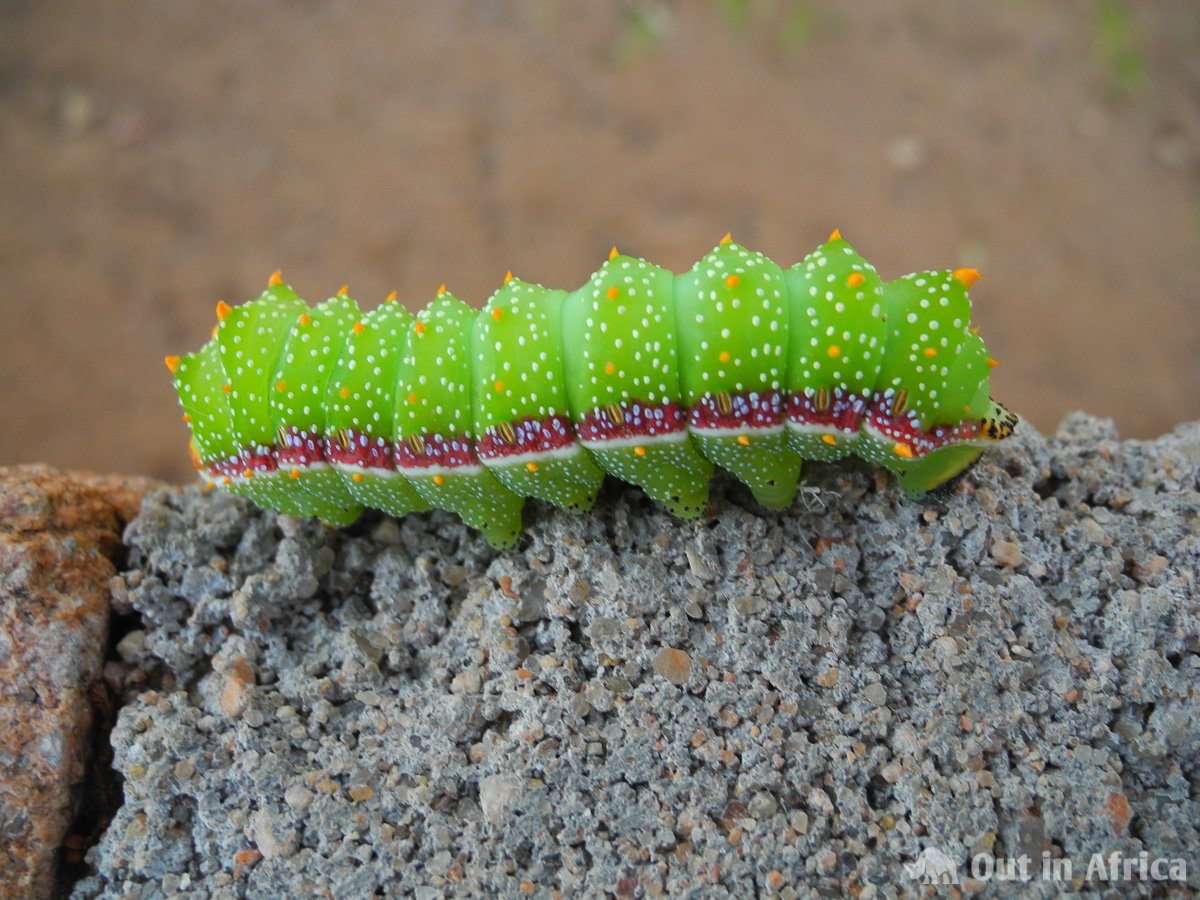
Mopane worms are the caterpillar of the moth Gonimbrasia belina and are considered a delicacy among the black population when dried and/or roasted. Anita had tasted them a few weeks before and found them very tasty. Now she wanted to buy more. You can’t buy them in a supermarket, but on the Open Market, they are available.
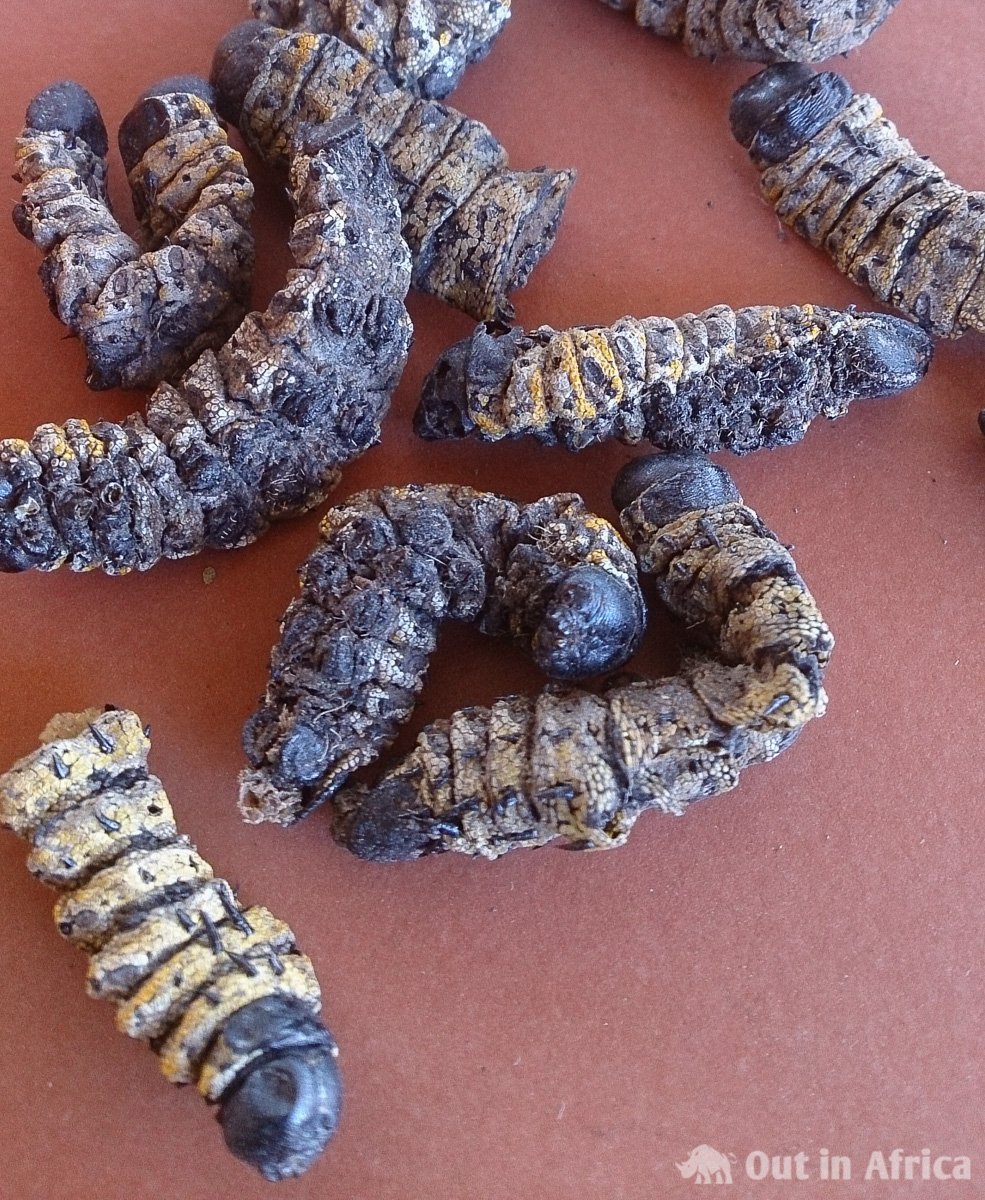
Our friends Naomi and Salome know their way around such markets and offered to go with us to Katutura. Yes, we had already gone to Katutura before, but the area is not completely safe for women. Or did we just find it threatening because it is different from the European Windhoek? We had already been to Open Markets before and therefore knew that communication is not always easy. Often the vendors can neither speak English nor Afrikaans, not to mention German. The culture is also different – you greet, express your thanks and say goodbye differently. Naomi and Salome can speak a little Oshiwambo and know how to behave there. Therefore, we were glad that they wanted to accompany us and also planned a lunch at the Xwama Traditional Restaurant in Wanaheda.
Oshetu Community Market
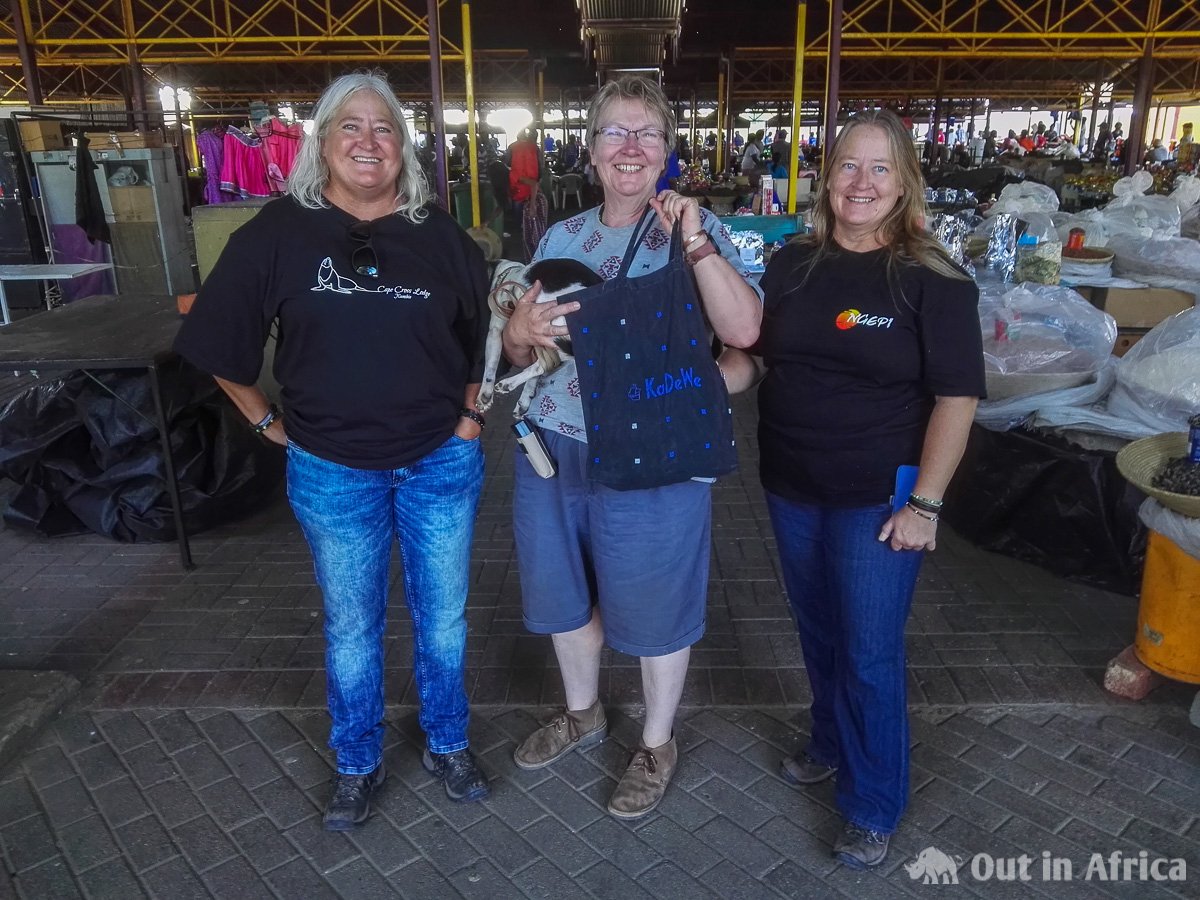
We drove to the Oshetu Community Market first. It’s quite easy to find: coming from the city, take Independence Avenue to Shanghai Street and then turn left. A few blocks down the road you can hardly miss the market on your right. We found a parking lot right in front of the entrance and a friendly young man agreed to take care of the car. Penny couldn’t stay in the car, so we tucked her under the arm and entered the large market area.
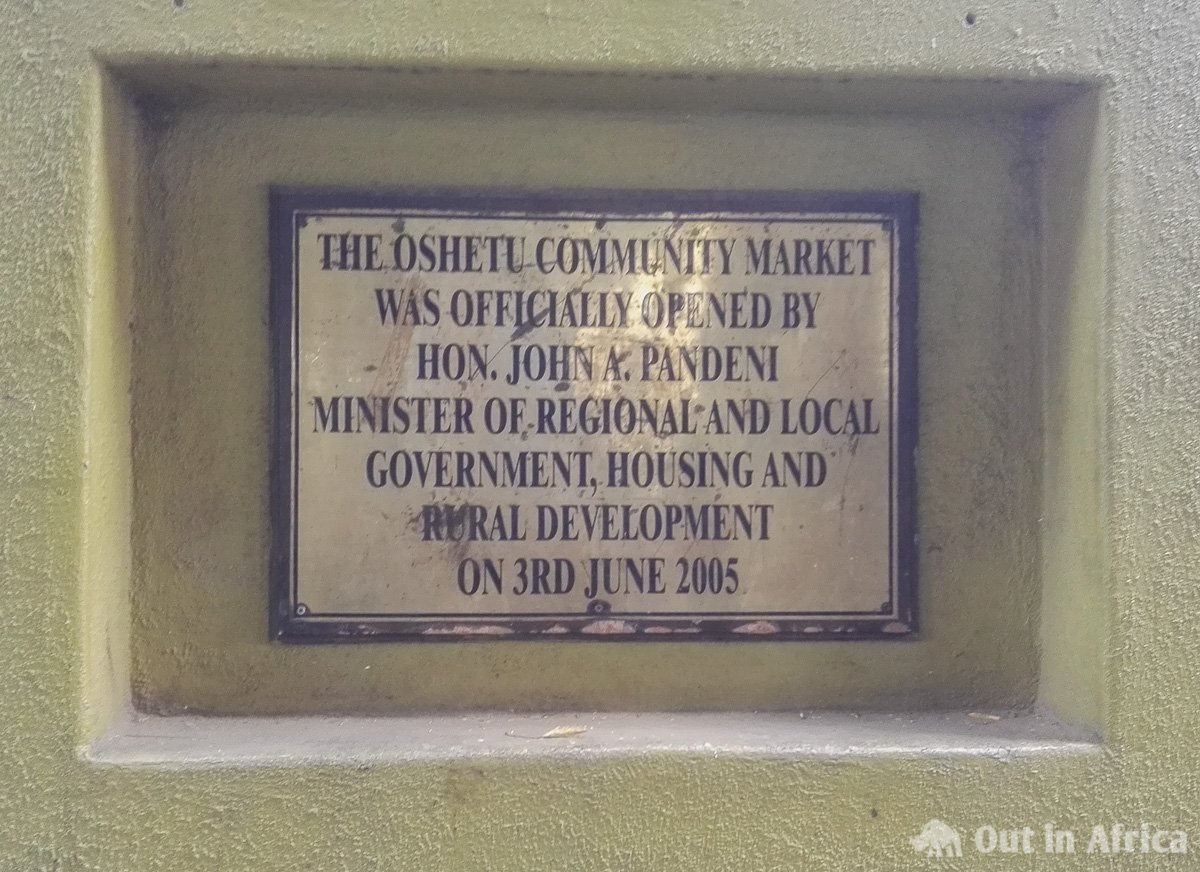
With “Open Market” one might think that it is a market that takes place on an open space. But most of these markets are covered to protect vendors and customers against the sun. However, there are many doorless openings on the sides so that a fresh breeze can blow through the market.
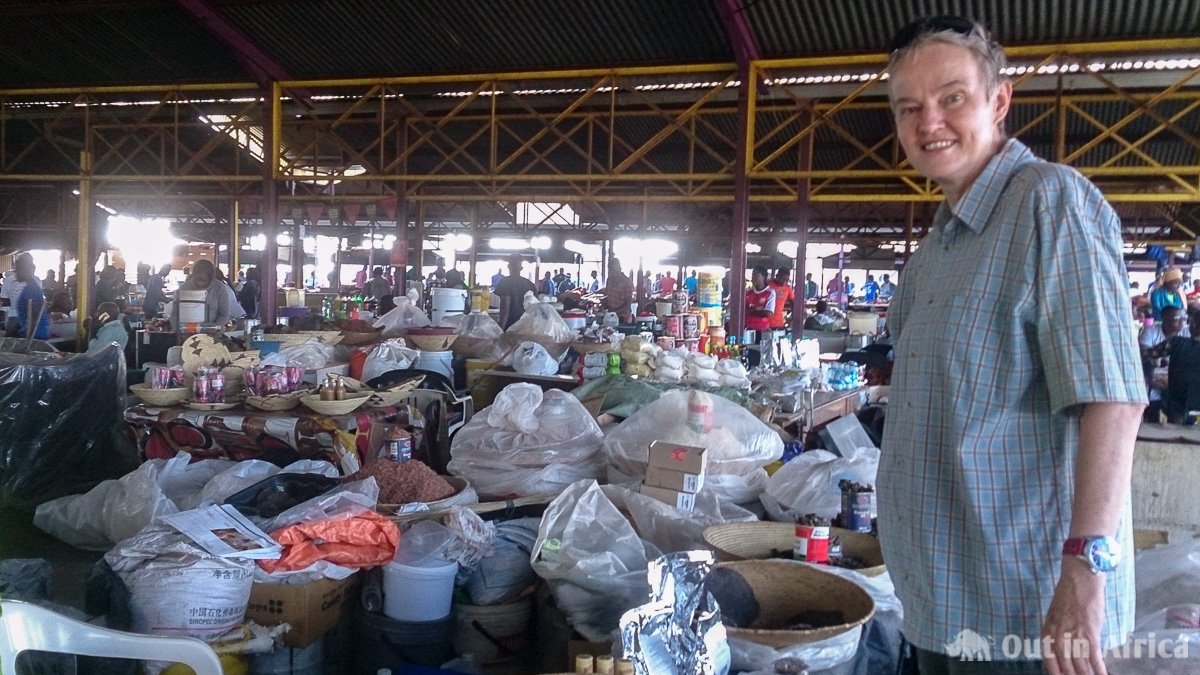
The market is divided into several areas, depending on the goods. On the one side are the butchers who cut up whole cattle and goats, then there are the grocers on one side and the takeaways on the other. Finally, there is a section that is non-food: hairdressing salons, manicure parlors and tailoring workshops.
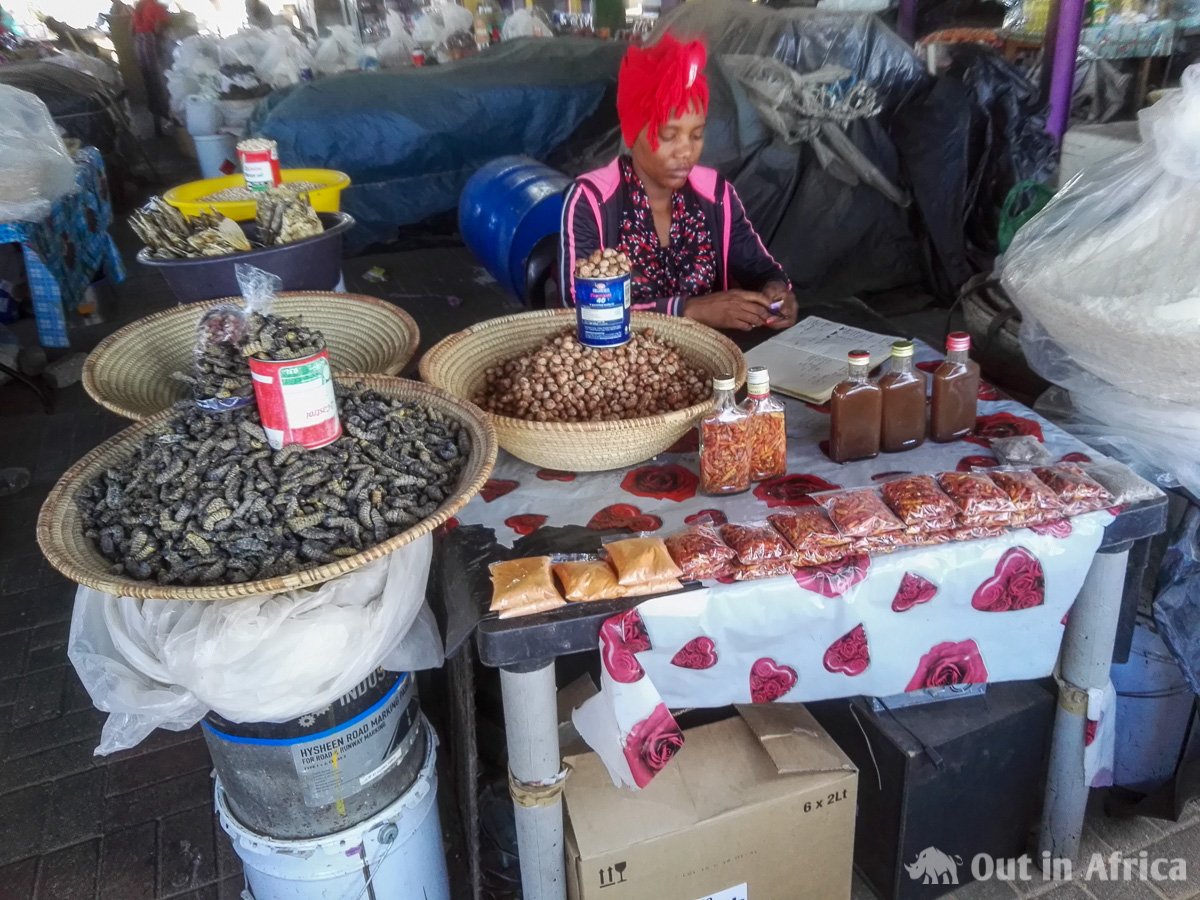
How do you conduct yourself in a traditional African market?
Most sellers can speak English, but some cannot. Even though we don’t know a native language, there is one language that is universal: the smile. We noticed that when we spoke to people in a friendly and respectful way or smiled at them, we were treated the same way. Sometimes we could only communicate with our hands and feet.
I had left my camera at home and only took the smartphone with me to take photos. Big white women are already conspicuous enough; big white women in full tourist outfits who photograph wildly around themselves are even more conspicuous. We wanted to experience the market, get to know the culture a little and not turn the locals into photographic objects. Therefore I want to say it straight away: If you go to an Open Market and want to take pictures there, ask the person if you are allowed to do so. This also applies if you want to photograph the market goods without people: Ask the vendor beforehand. Most of them said “yes”, but there were also a few refusals that I respected. You won’t see a picture of the meat market here, although there were many good pictures. The vendors didn’t want me to take pictures there.
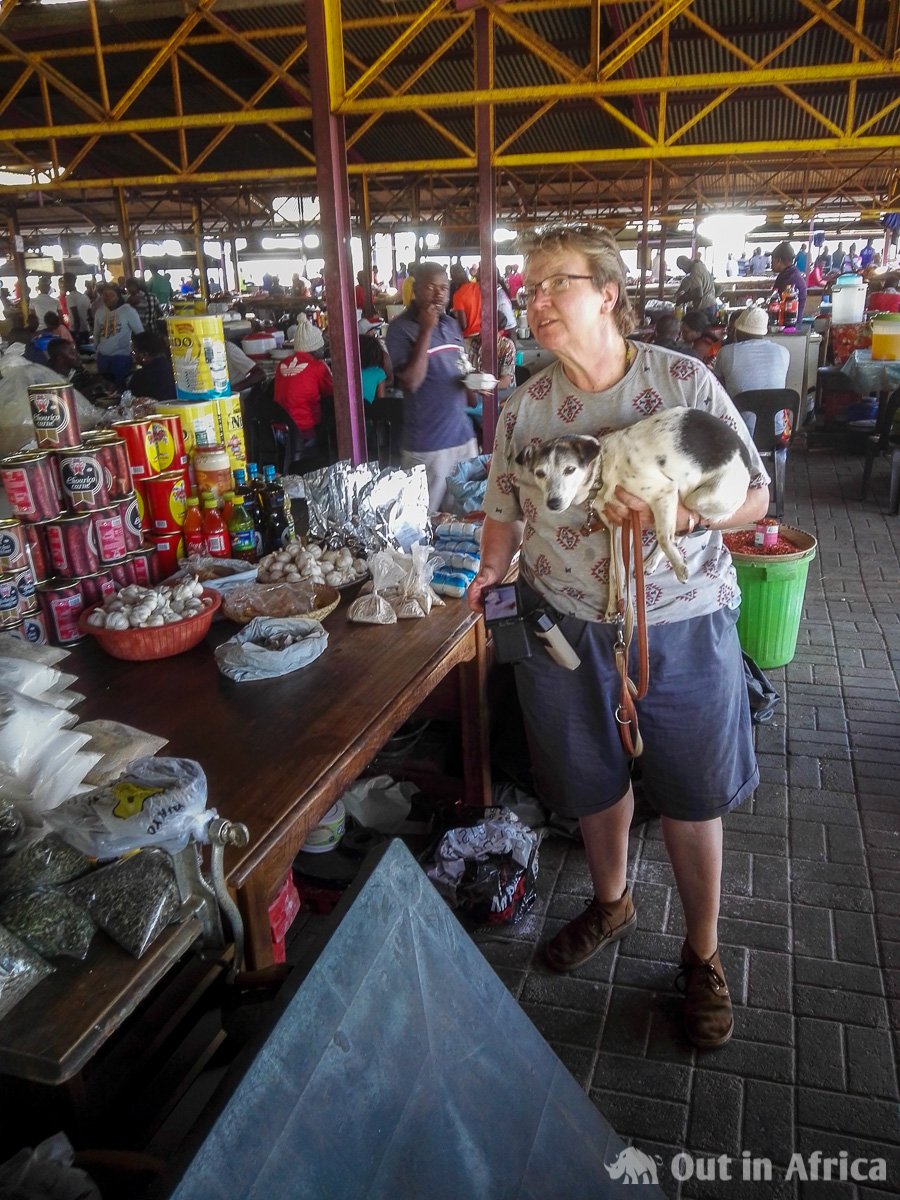
Also, we had not taken the thick purse with all papers and bank cards, but put some larger and smaller bills in our trouser pockets. It might sound a little paranoid that we didn’t take our valuables with us and maybe it’s also exaggerated caution, because of course not all inhabitants of Katutura are criminals who want to steal money, jewellery and photo equipment. But the local women are also cautious and don’t walk around with handbags and full purses, but prefer to store their money in their bra.
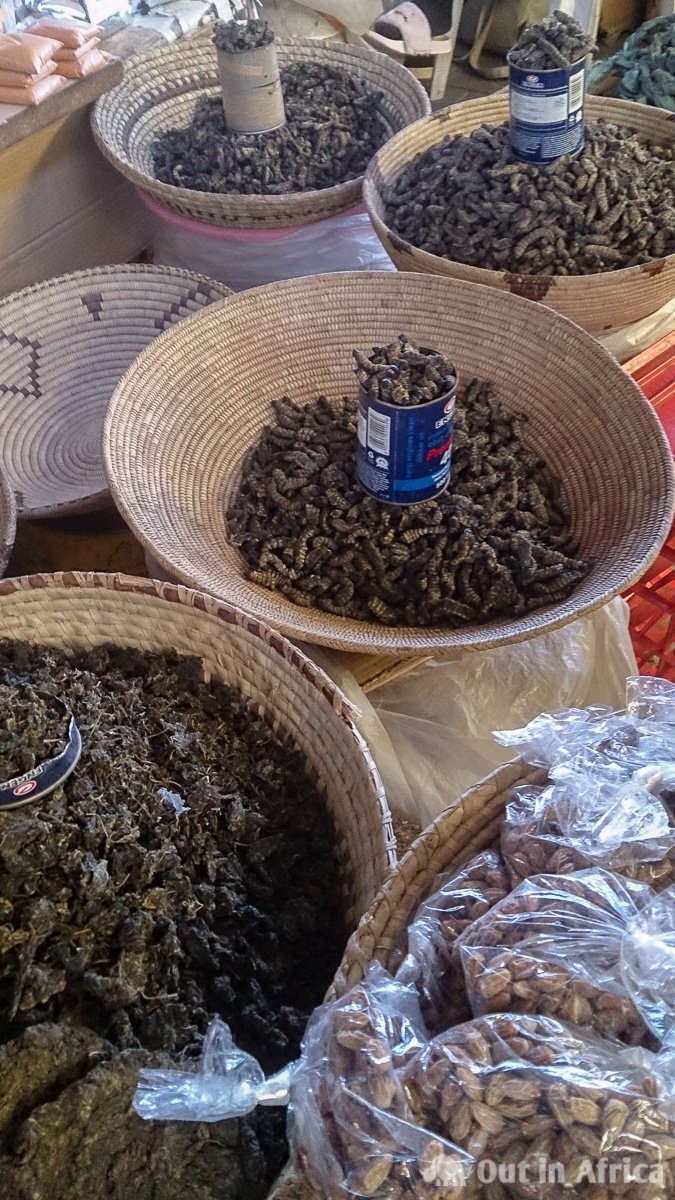
At the food stalls
First we went to the grocery section. Most of the goods there were dried. There are no freezers, but mountains and sacks of beans, millet, dried fruit, dried spinach and dried fish.
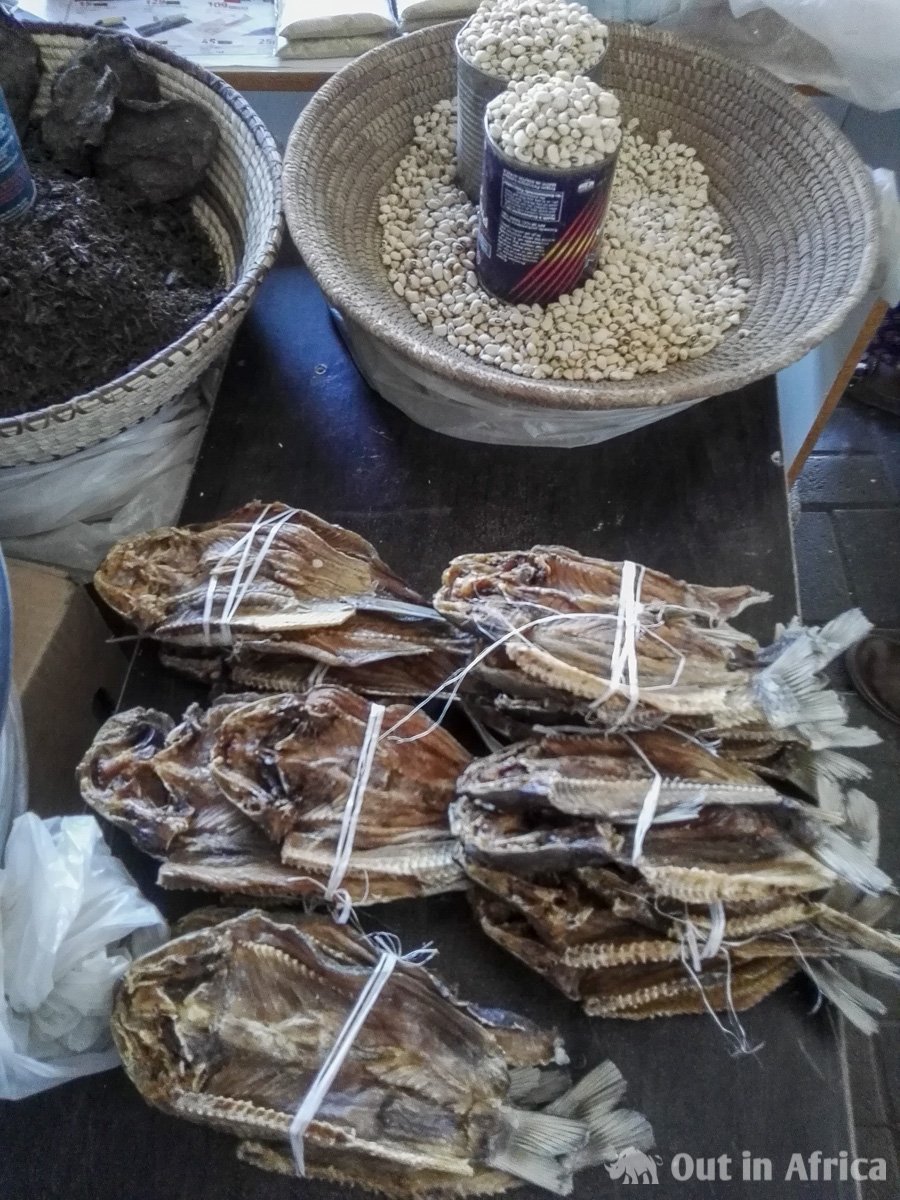
And then mopane worms. It was the mopane worm season in May, and almost every market stall offered them for sale. Outside, in the sun, new supply was dried on large tarpaulins.

The dry foods are offered in baskets or bags, and they are always bought by the measure: an old motor oil can. If we wanted less, we still paid as much as a full can.
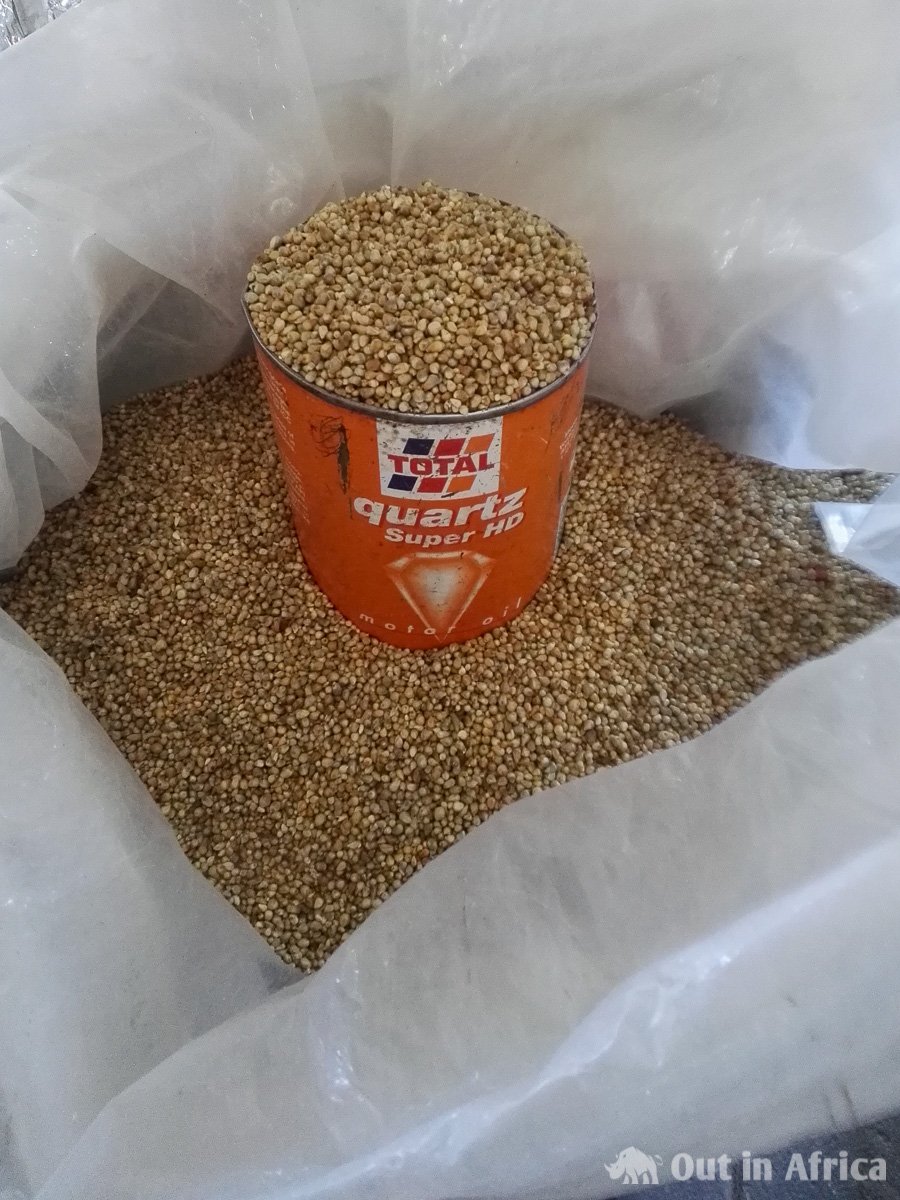
Thanks to Naomi and Salome, who translated for us, we were able to ask a lot of questions about the foreign food and its preparation. Now and then we were allowed to taste the Baobab pulp and Eembe (raisin-sized dried fruits). Our shopping bag filled up very fast.
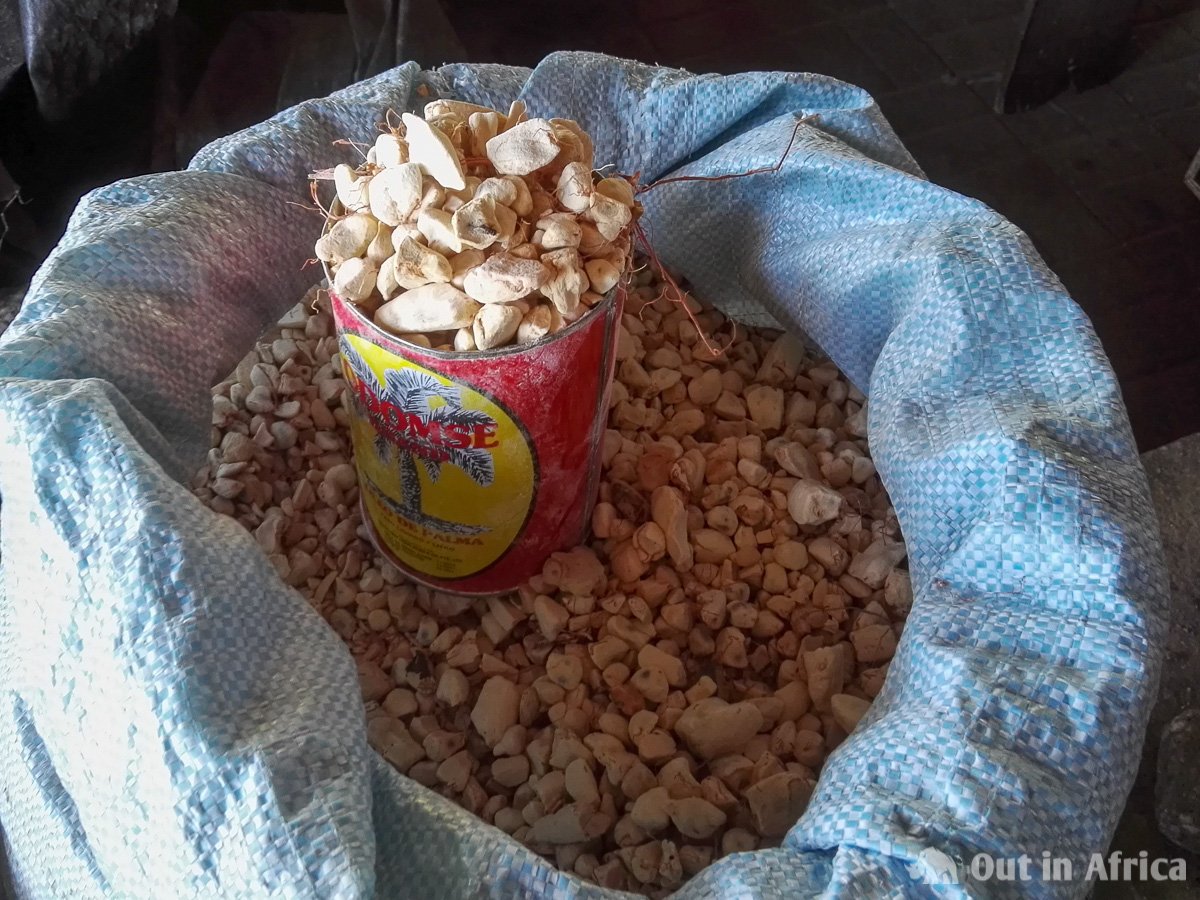
Since we still wanted to eat in a traditional restaurant, we did not buy anything at one of the take-away stalls. But if you are hungry in such a market, I recommend Vetkoek (pronounced: Fat cook). Vetkoek are like doughnuts, but without jam and very tasty. If you’re more into meat, buy Kapana. Kapana is the Namibian form of barbeque and is also called Braaivleis by the white population.
Tailoring workshops, hairdressing salons and manicure parlors
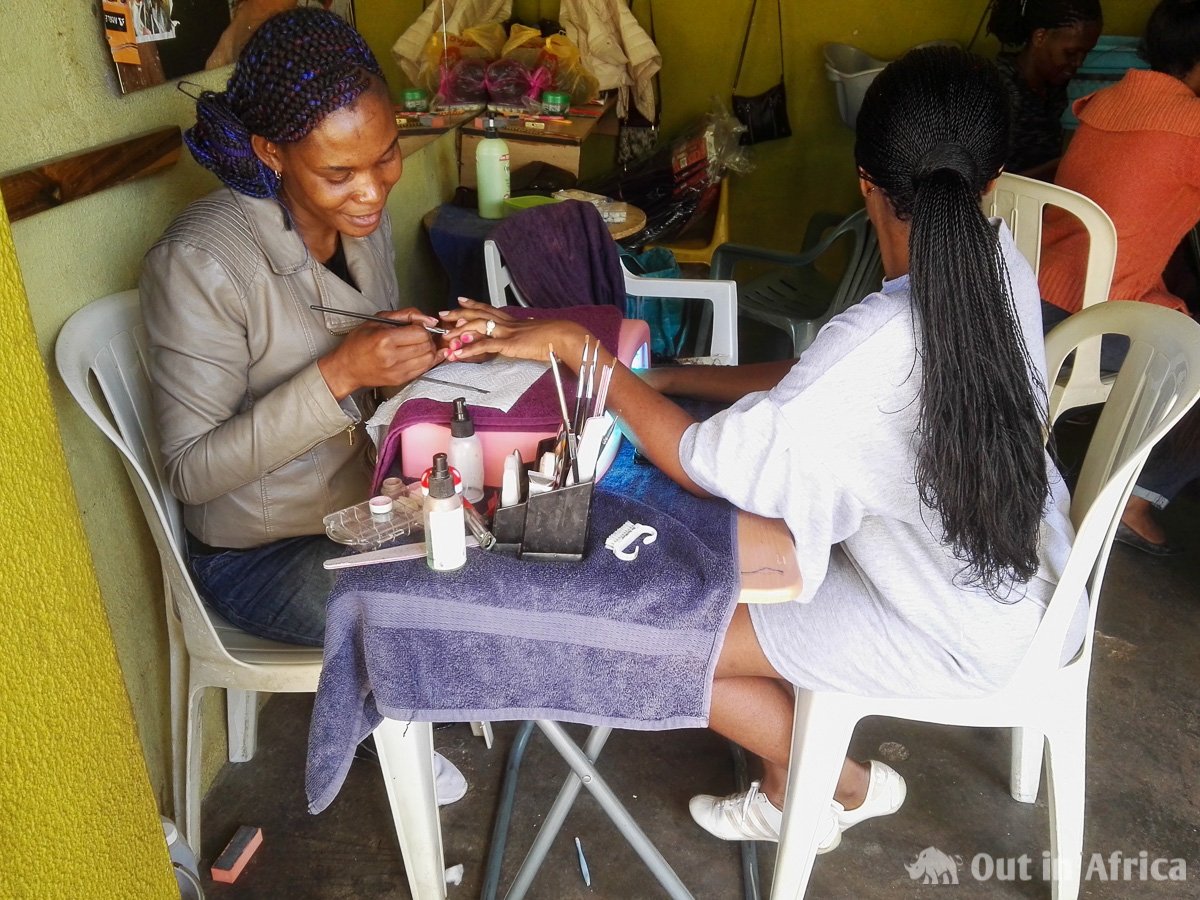
Then we went to the side of the market where no food was offered for sale, but clothes and services such as hairdressing salons or manicure parlors. Here are the shops in rooms that can be locked at night.

It was very colorful there and we were also approached friendly there and could chat a little. It was remarkable that here men were the tailors who sewed colorful clothes and shirts with big modern sewing machines.
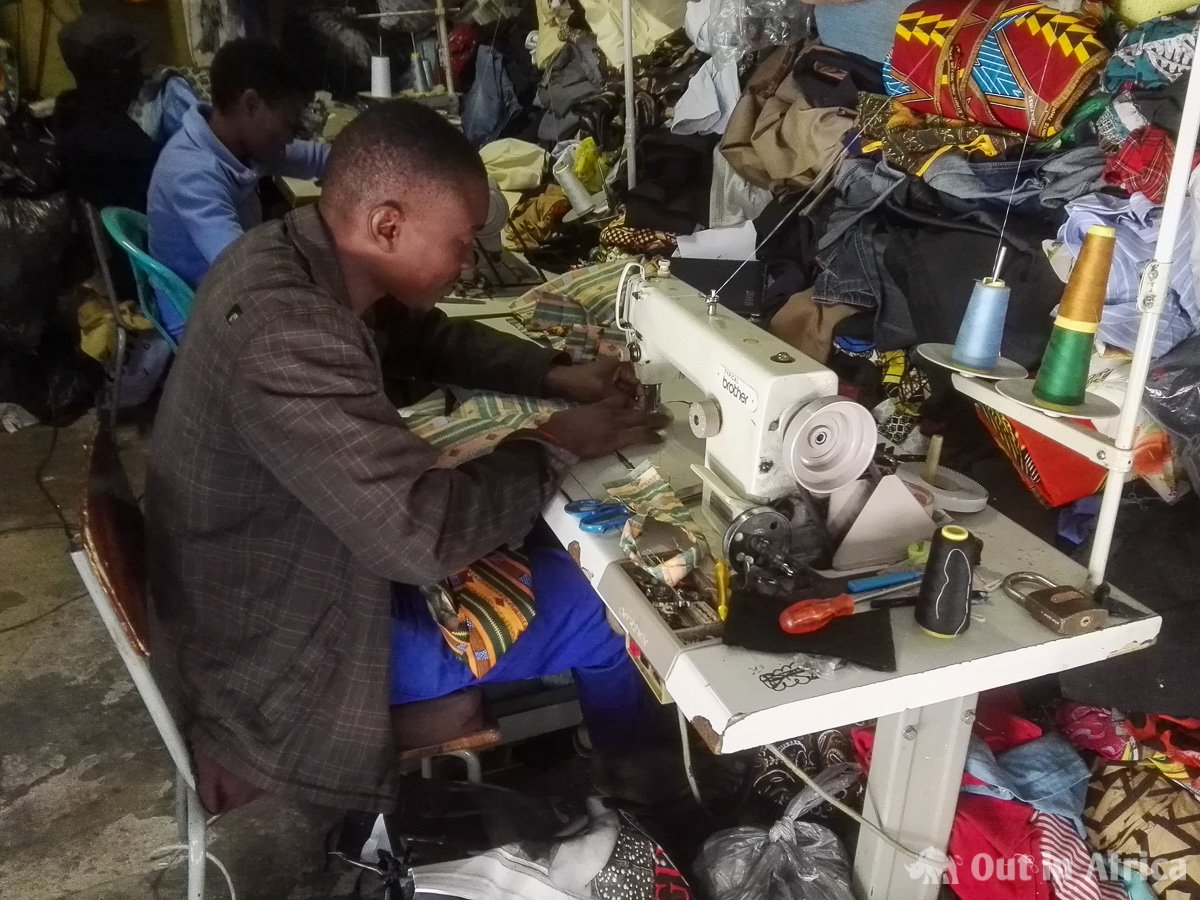
Xwama Traditional Restaurant
We left the market in a good mood, stowed our goods away in the car, paid a tip to the car guard and made our way to the Xwama Traditional Restaurant: on Shanghai Street back to Independence Avenue and then further west to Omongo Street. The building cannot be overlooked. There is a parking lot protected from the criminals on the backyard.
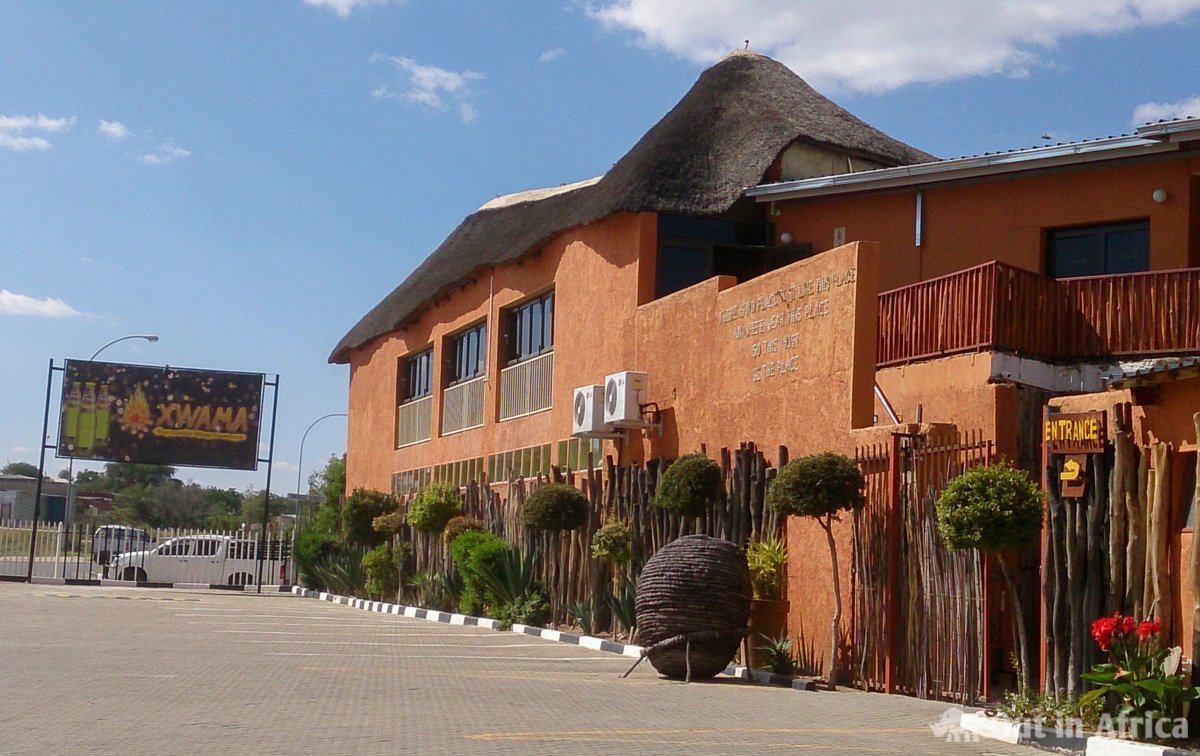
We were warmly welcomed and first shown around. The Xwama is not only a restaurant, but also a cultural centre, which wants to introduce the guests to the Ovambo culture.
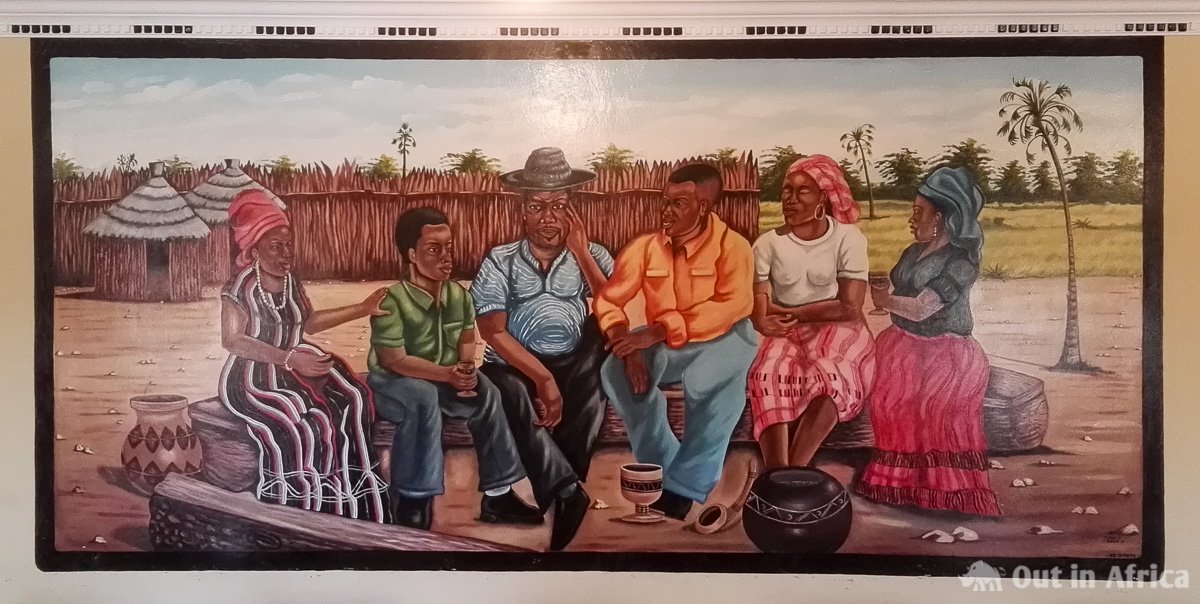
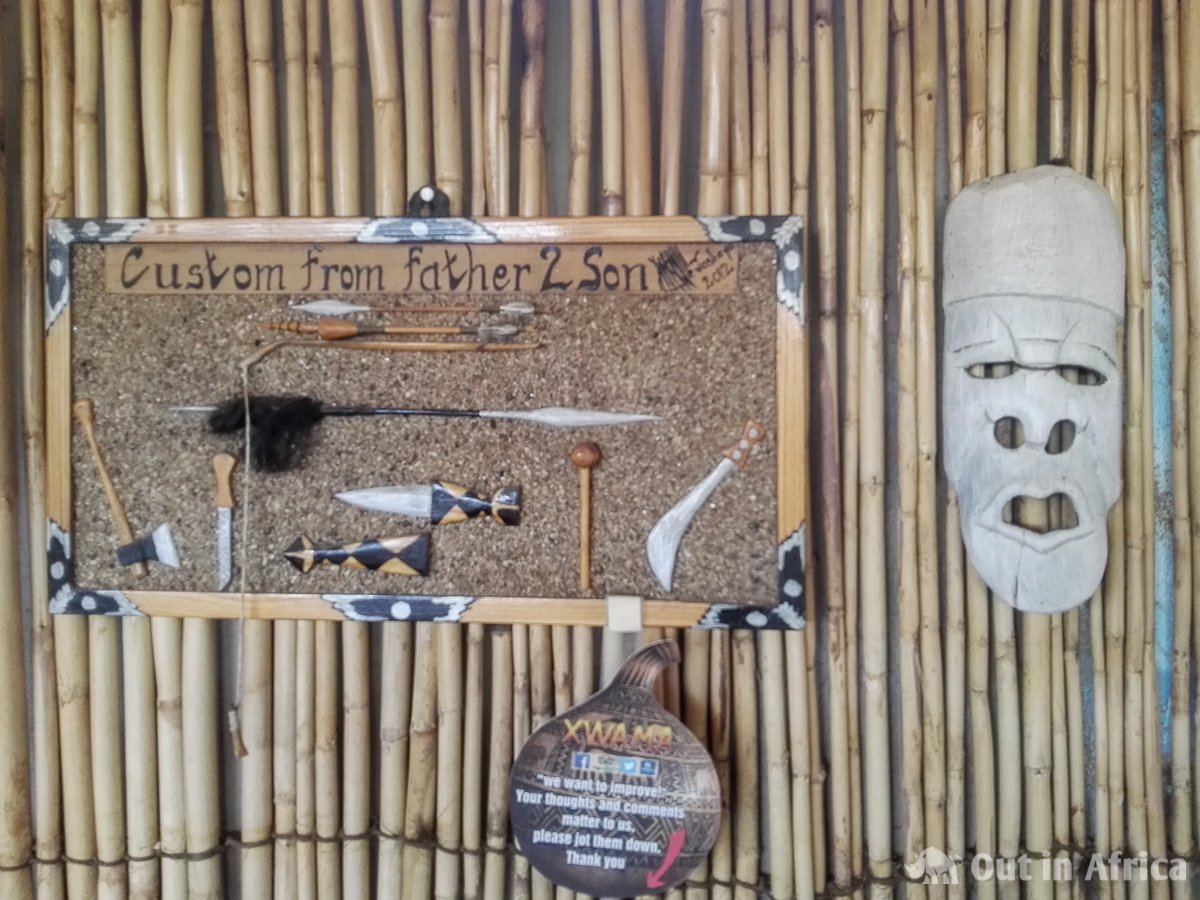
There are also a few conference rooms, which can be rented, of course with full catering.
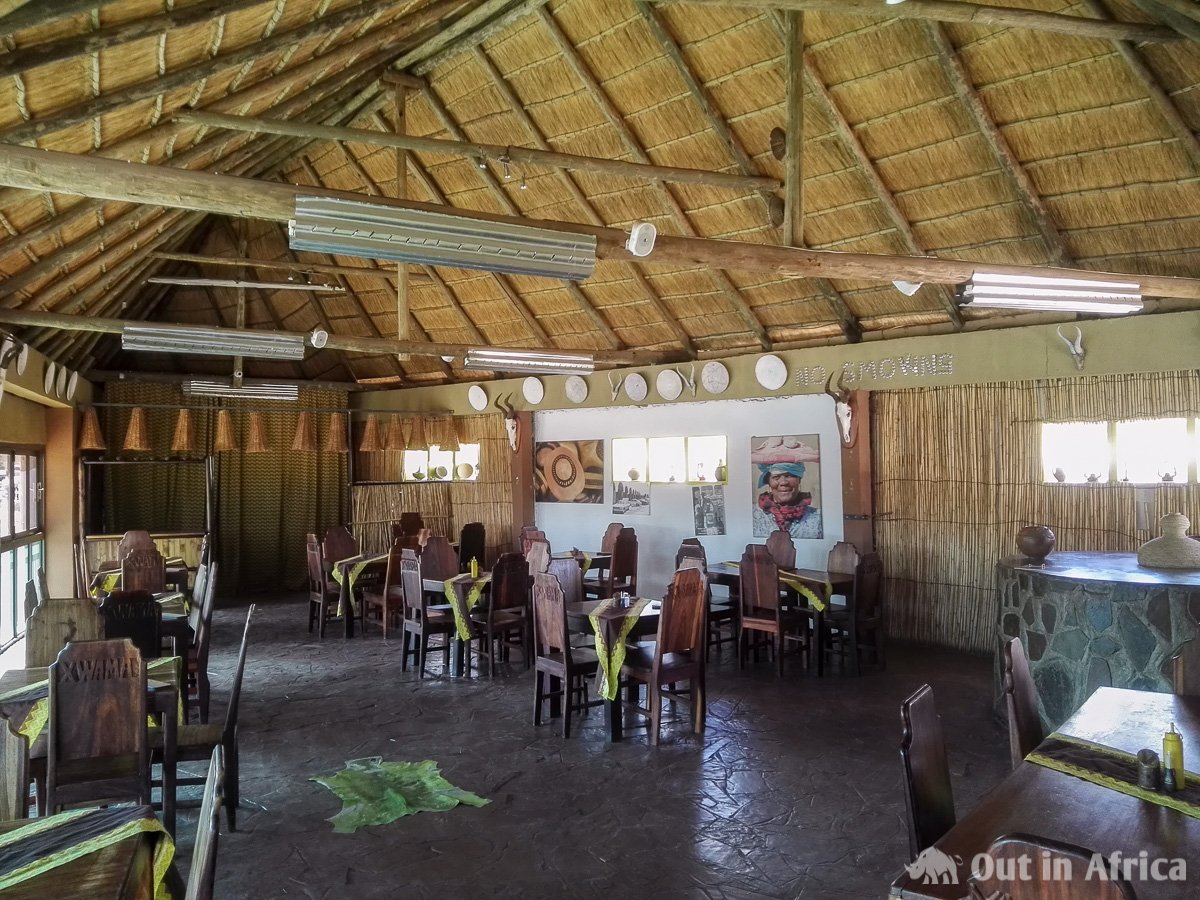
A target group of the restaurant are tourists. There are tables and chairs like in a typical restaurant. The toilets are well maintained. The service in the restaurant is amiable – always there when you need them, but never intrusive.

The menu of the Xwama Traditional Restaurant
As soon as we opened the menu, we left the familiar terrain of our own culture and had to consider whether we would rather eat chicken feet or mopane worms.
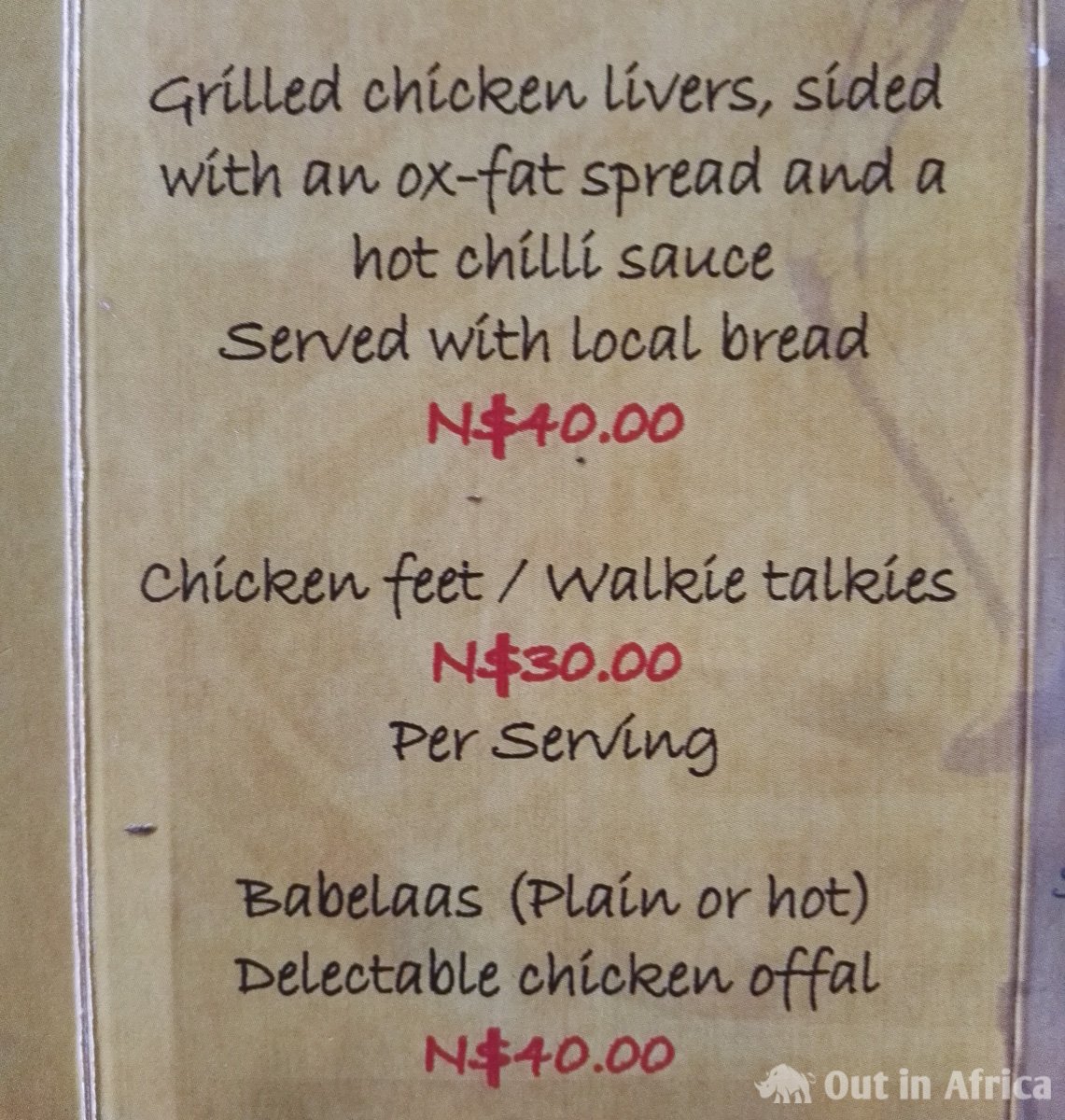
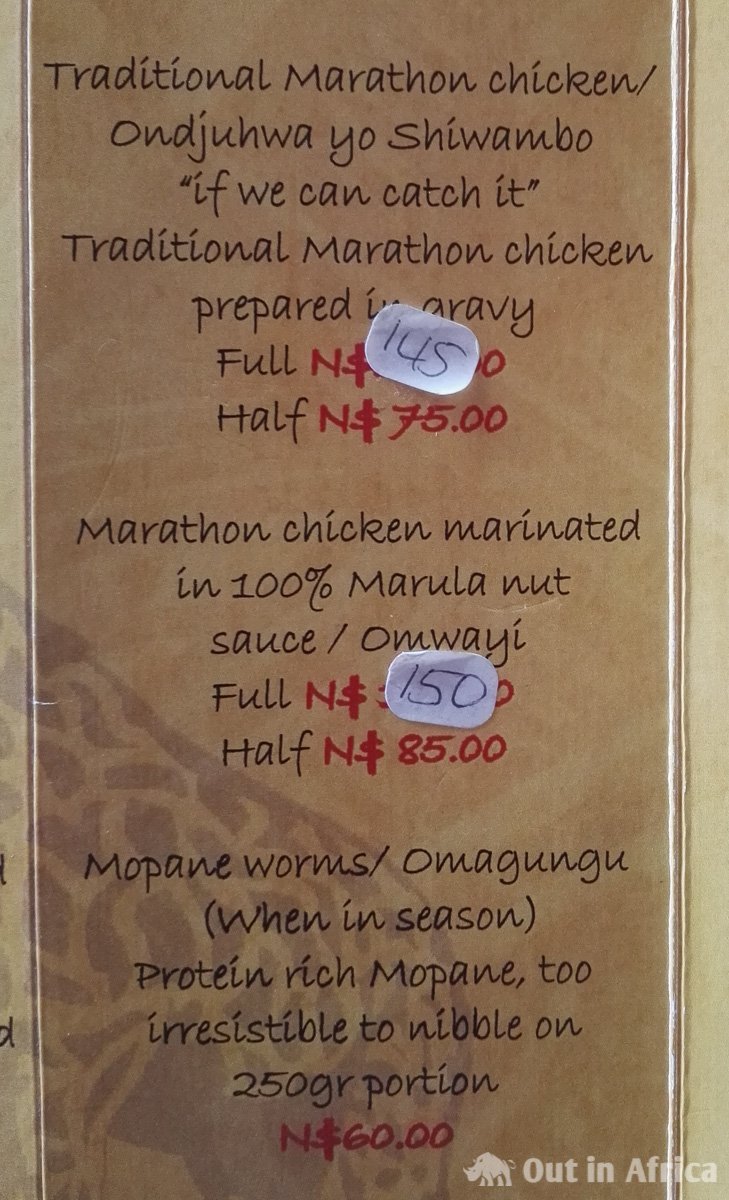
Naomi and Salome raved about marathon chicken, best marinated in marula oil. There was no Marula oil available at the time, but we had bought some on the market and got it out of the car without further ado.
I also took Marathon Chicken with Mahangu, a millet porridge. Anita wanted to have a vegetarian meal and definitely wanted to try the wild spinach and decided on Mahangu with Omavanda.
What did we want to drink? Since we like to take what we don’t know yet, we decided for Oshikundu, a non-alcoholic brew made of millet. It tastes slightly sour and is sweetened with a little sugar. I drank my cup, but it wasn’t entirely my case. So later I switched to the tried and tested Windhoek beer.
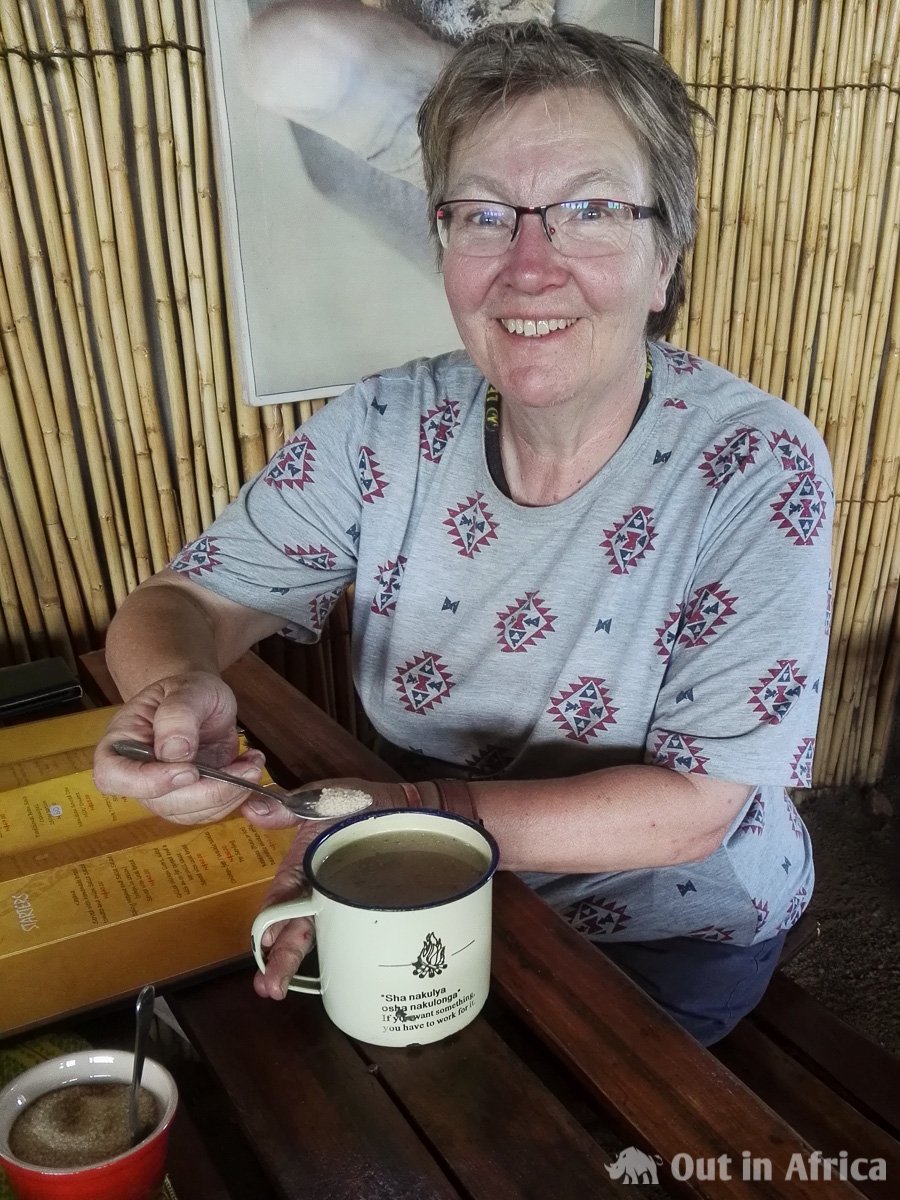
Before the meal was served, a young woman came with a pot of warm water and a bowl. In Africa, people traditionally don’t eat with a knife, fork or spoon, but with their fingers. Therefore it was vital that we washed our hands before eating.
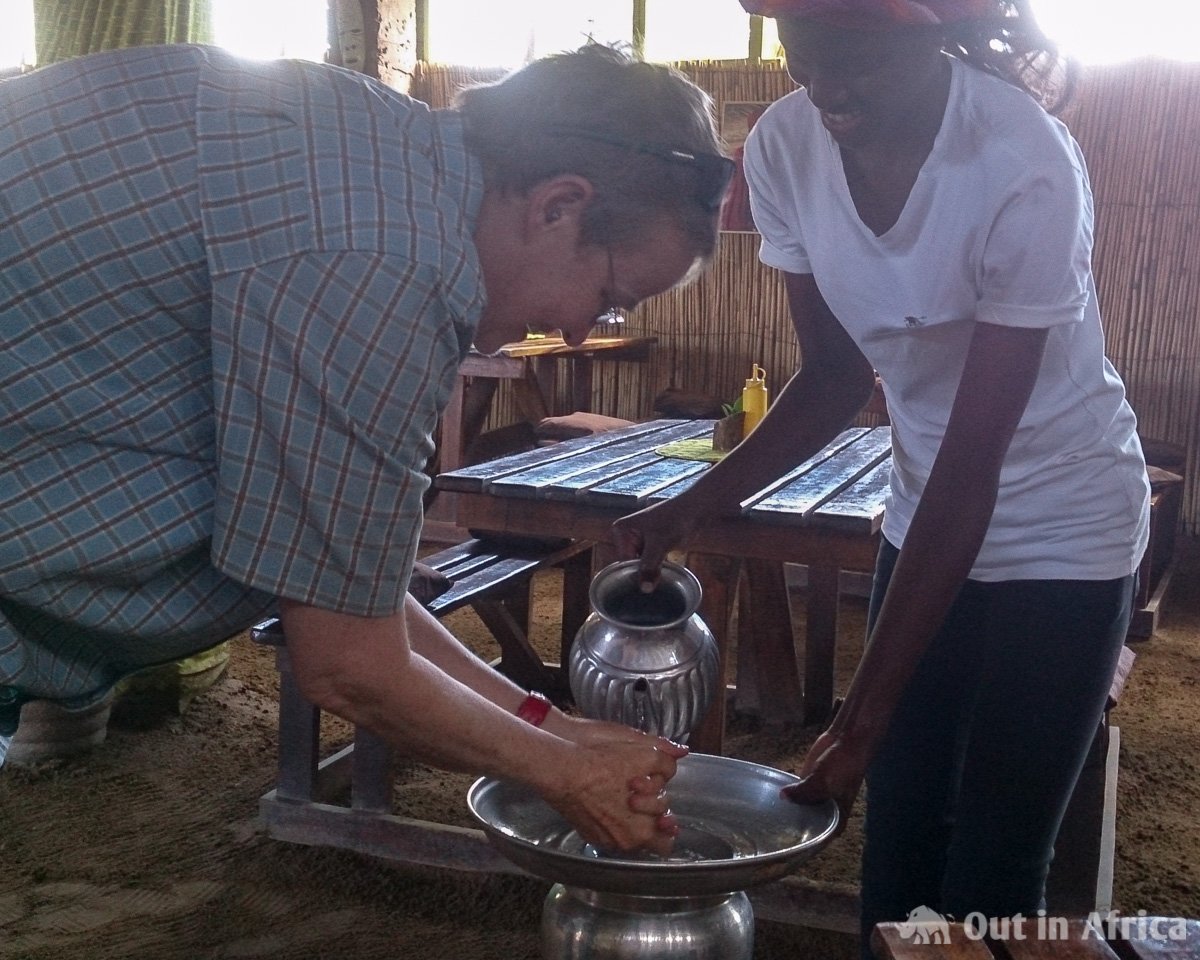
The food of the Xwama Traditional Restaurant
The food came and was delicious. I like to eat Mahangu, the firm millet porridge dunked into the sauce. The chicken, half a bird, was not a supermarket product and a little too chewy for me. Probably it had actually run a marathon before it ended up in a pot.
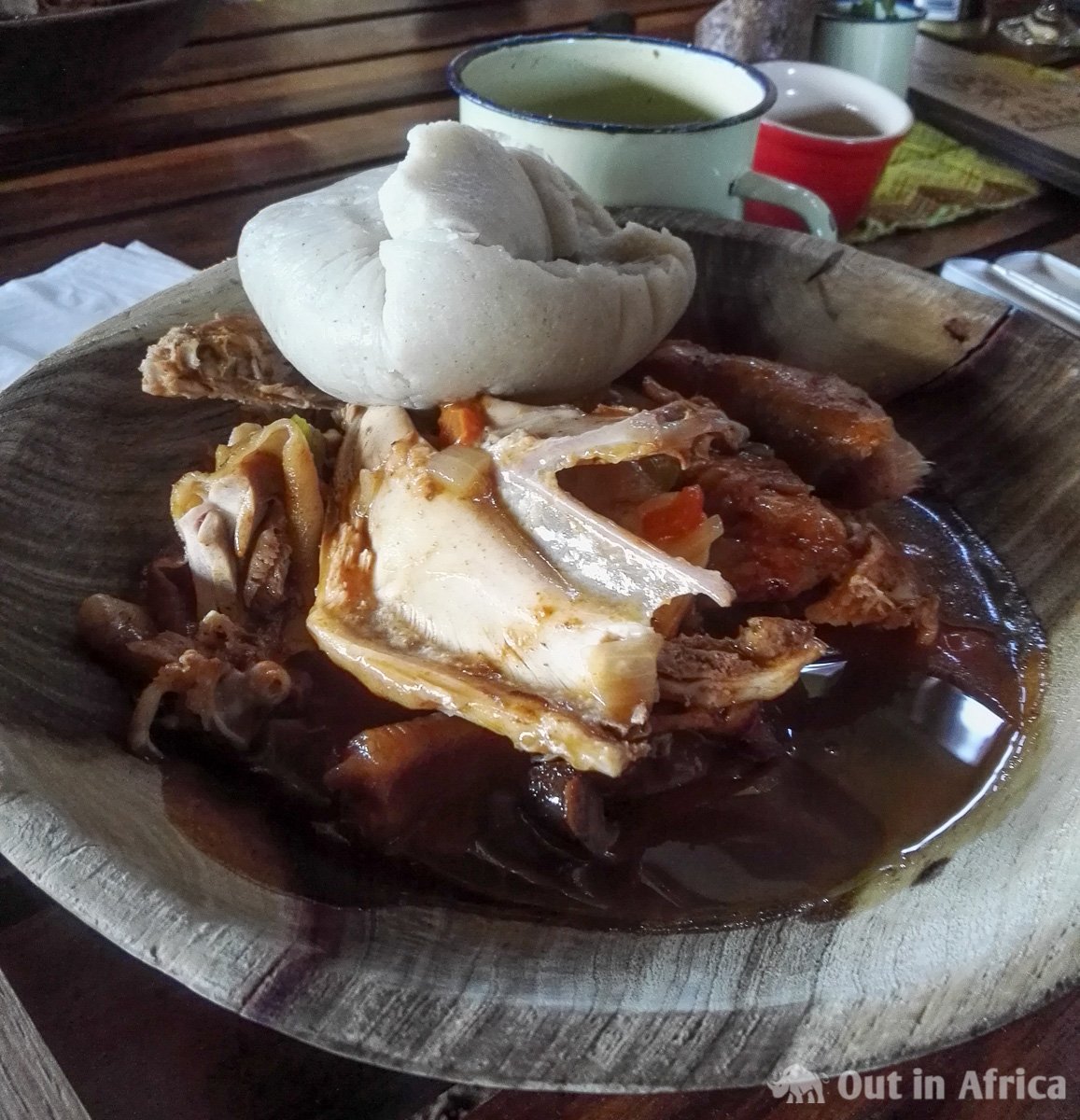
The chicken’s feet were also served, but I didn’t eat them. For many other people, they are a delicacy. The sauce, refined with a little marula oil, was delicious.
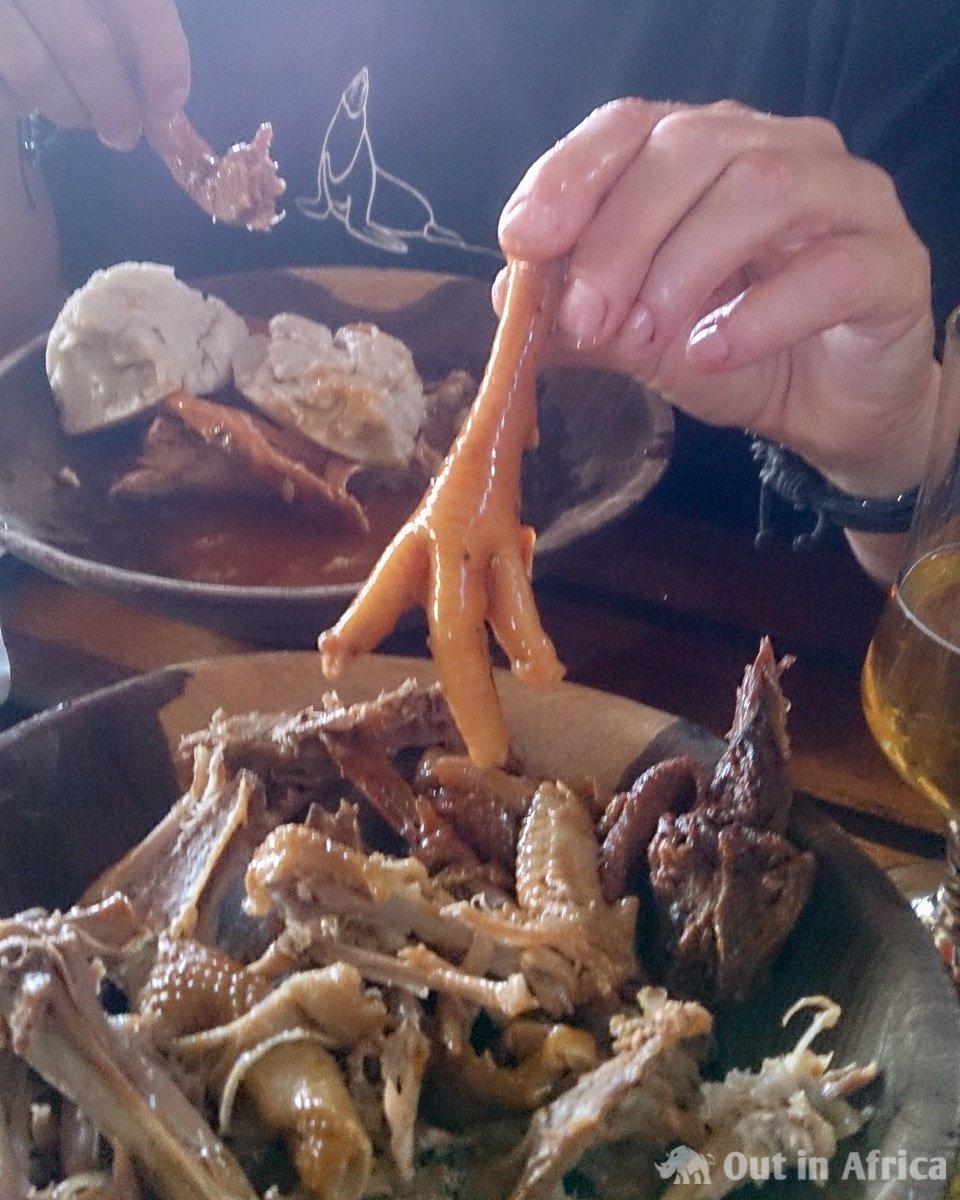
Anita was pleased with her Mahangu and Omawanda, a kind of spinach.
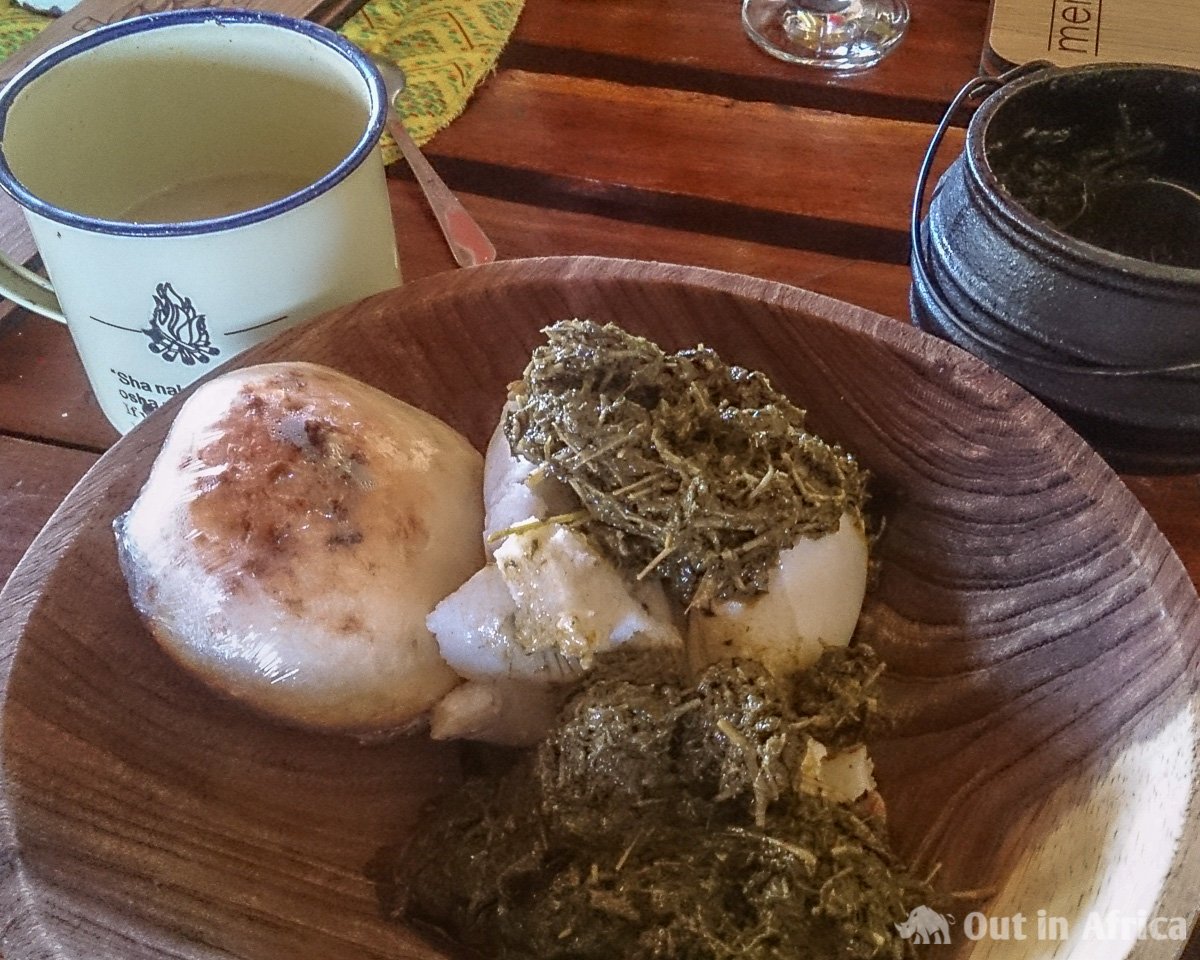
I have a personal quirk that a little spoiled the pleasure of eating for me: I don’t like to eat with my fingers. I also want to eat European food that is actually eaten with the hands with a knife and fork. However, this is my personal thing, and if I had asked for cutlery, they would have brought it to me. But I didn’t want that either – I wanted to eat the traditional food traditionally.
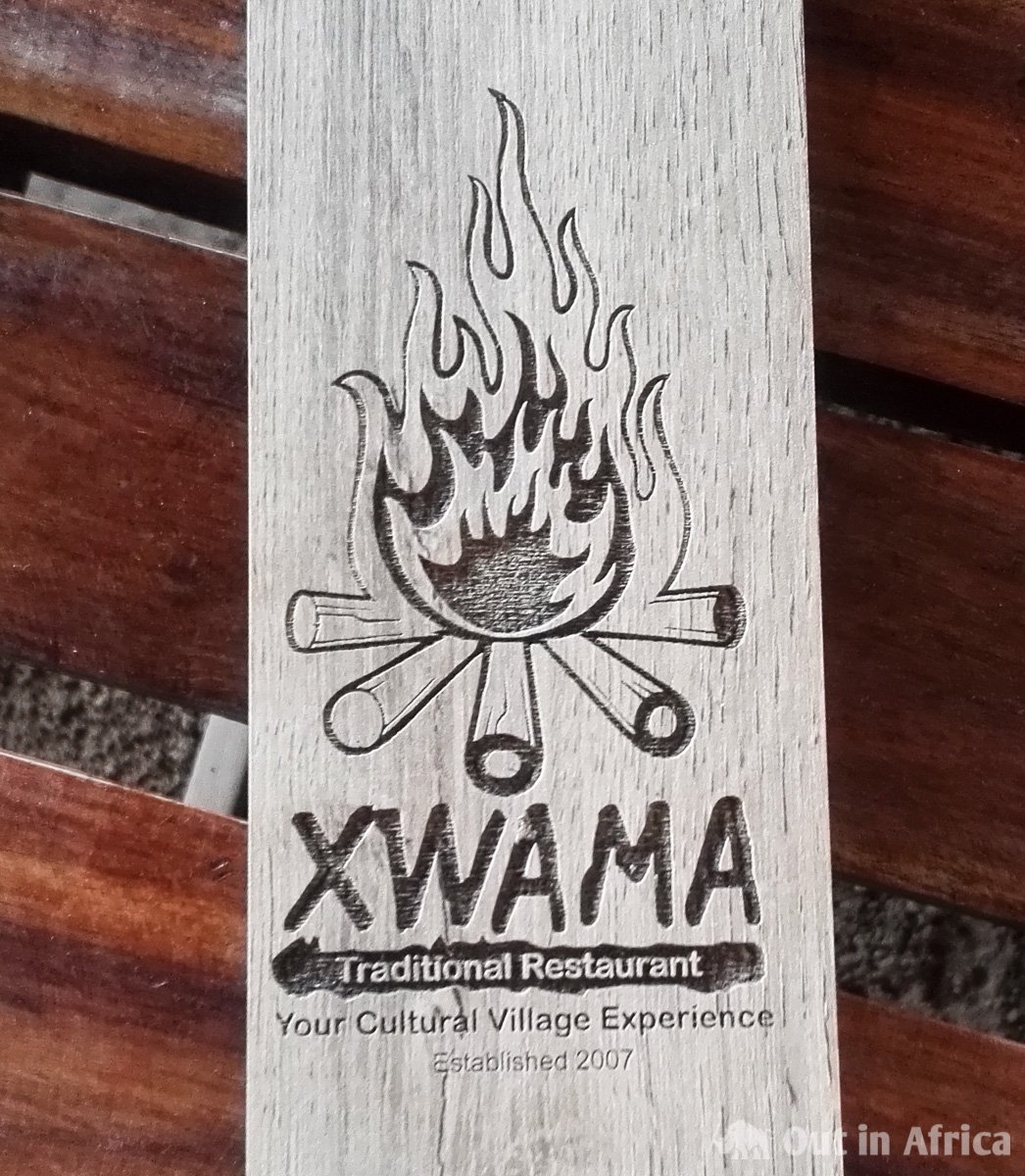
I would revisit the Xwama and recommend it to anyone who wants to eat traditional African cuisine. But next time I would probably instead take the grilled chicken liver with bread.
Tips:
- Go with someone who knows the language and culture. If you don’t know anyone like Naomi and Salome, there are also travel guides that will introduce you to Katutura, such as Bwana Tucke Tucke.
- Restrain yourself from taking pictures. Ask before taking a picture and respect a no.
Other Websites
Links about Katutura
Links about the Old Location
Links about the Oshetu Community Market
Links to Xwama Traditional Restaurant
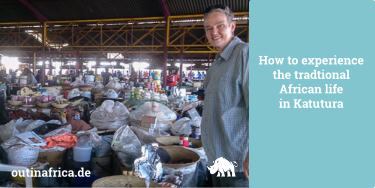
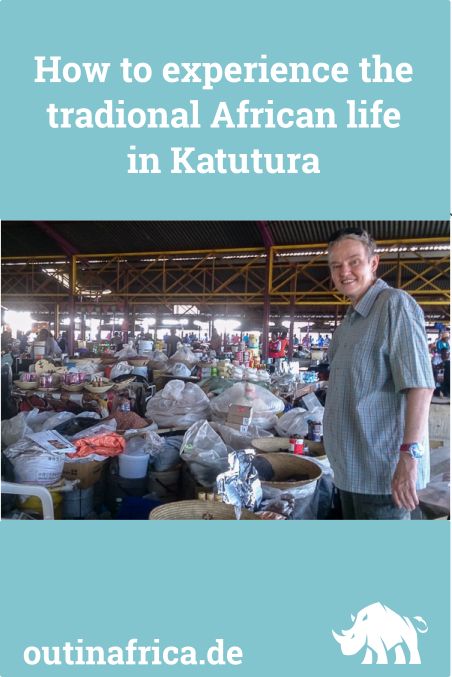

Leave a Reply